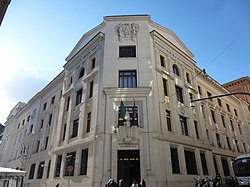
Riomaggiore is a village and commune in the province of La Spezia, situated in a small valley in the Liguria region of Italy. It is the first of the Cinque Terre one meets when travelling north from La Spezia.
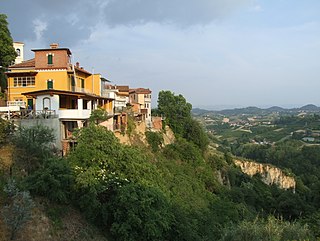
Monteu Roero is a comune (municipality) in the Province of Cuneo in the Italian region Piedmont, located about 35 km (22 mi) southeast of Turin and about 50 km (31 mi) northeast of Cuneo.
The Italian society of economics demography and statistics is a learned society aiming to further economic, demographic, and statistical studies and to establish active co-operation among professionals of the mentioned subjects in the field of social sciences and human behaviour. The society pursues this aim by:
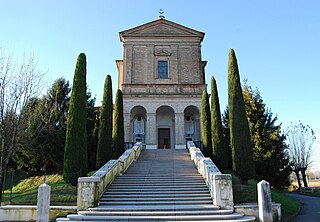
Casalmoro is a comune (municipality) in the Province of Mantua in the Italian region Lombardy, located about 100 kilometres (62 mi) east of Milan and about 35 kilometres (22 mi) northwest of Mantua. As of 1 January 2007, it had a population of 2,154 and an area of 13.9 square kilometres (5.4 sq mi).
Casaloldo is a comune (municipality) in the Province of Mantua in the Italian region Lombardy, located about 110 kilometres (68 mi) east of Milan and about 25 kilometres (16 mi) northwest of Mantua. As of 31 December 2004, it had a population of 2,436 and an area of 16.8 square kilometres (6.5 sq mi).
Casalromano is a comune (municipality) in the Province of Mantua in the Italian region Lombardy, located about 100 kilometres (62 mi) southeast of Milan and about 35 kilometres (22 mi) west of Mantua. As of 31 December 2004, it had a population of 1,568 and an area of 11.9 square kilometres (4.6 sq mi).
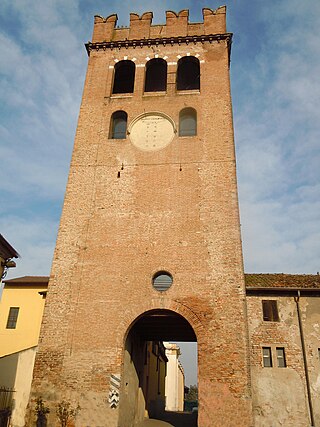
Castellucchio is a comune (municipality) in the Province of Mantua in the Italian region Lombardy, located about 120 kilometres (75 mi) southeast of Milan and about 12 kilometres (7 mi) west of Mantua.

Ceresara is a comune (municipality) in the Province of Mantua in the Italian region Lombardy, located about 110 kilometres (68 mi) east of Milan and about 20 kilometres (12 mi) northwest of Mantua. As of 31 December 2004, it had a population of 2,544 and an area of 37.8 square kilometres (14.6 sq mi).

Mariana Mantovana is a comune (municipality) in the Province of Mantua in the Italian region Lombardy, located about 110 kilometres (68 mi) southeast of Milan and about 25 kilometres (16 mi) west of Mantua.
Motteggiana is a comune (municipality) in the Province of Mantua in the Italian region Lombardy, located about 130 kilometres (81 mi) southeast of Milan and about 15 kilometres (9 mi) south of Mantua. As of 31 December 2004, it had a population of 2,629 and an area of 24.6 square kilometres (9.5 sq mi).

Ponti sul Mincio is a comune (municipality) in the Province of Mantua in the Italian region Lombardy, located about 120 kilometres (75 mi) east of Milan and about 25 kilometres (16 mi) northwest of Mantua. As of 31 December 2004, it had a population of 2,037 and an area of 11.8 square kilometres (4.6 sq mi).
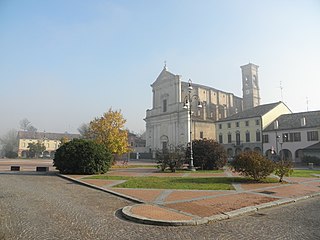
Quingentole is a comune (municipality) in the Province of Mantua in the Italian region Lombardy, located about 160 kilometres (99 mi) southeast of Milan and about 30 kilometres (19 mi) southeast of Mantua.

San Martino Dall'argine is a comune (municipality) in the Province of Mantua in the Italian region Lombardy, located about 110 kilometres (68 mi) southeast of Milan and about 25 kilometres (16 mi) southwest of Mantua.

Sustinente is a comune (municipality) in the Province of Mantua in the Italian region Lombardy, located about 140 kilometres (87 mi) southeast of Milan and about 11 kilometres (7 mi) southeast of Mantua.
Giardinello is a comune (municipality) in the Metropolitan City of Palermo in the Italian region Sicily, located about 20 kilometres (12 mi) west of Palermo. As of December 2010, it had a population of 2,260 and an area of 12.5 square kilometres (4.8 sq mi).

Enrico Giovannini is an Italian economist, statistician and academic, member of the Club of Rome. Since February 2021, he has been serving as Minister of Infrastructure and Sustainable Mobility in the Draghi Government. From April 2013 to February 2014, he served as Minister of Labour and Social Policies in the Letta Government. From 2009 to 2013, he held the office of President of the Italian National Institute of Statistics (Istat).
Within each country GDP is normally measured by a national government statistical agency, as private sector organizations normally do not have access to the information required.
Rodolfo Benini was an Italian statistician and demographer.

Gaetano Pietra was an Italian statistician.
Environmental protection expenditure accounts (EPEA) are a statistical framework that describes environmental activities in monetary terms and organises these statistics into a full set of accounts, just like that of the national accounts. The EPEA is part of the System of Integrated Environmental and Economic Accounting which, in March 2012, was adopted as a statistical standard by the United Nations Statistical Commission.
